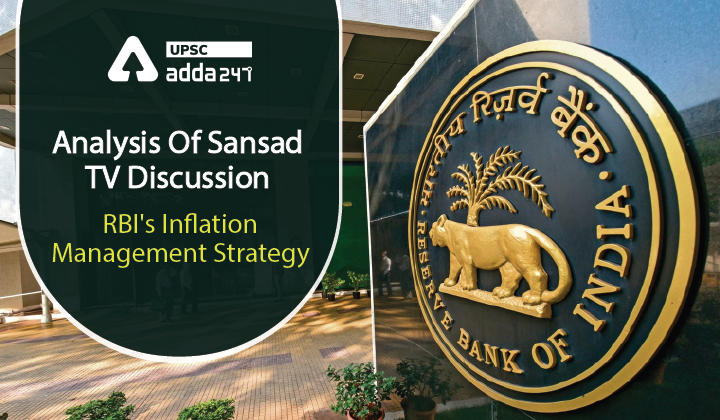Table of Contents
Analysis Of Sansad TV Discussion
”RBI’s Inflation Management Strategy”
Relevance
GS 3: Growth & Development, Monetary Policy, Banking Sector & NBFCs
Context
- On May 4, 2022, RBI Monetary Policy Committee (MPC) unanimously decided to raise the benchmark interest rate in the economy — the repo rate or the rate at which the RBI lends money to commercial banks — from 4% to 4.40%.
- By raising the repo rate, the RBI hopes to incentivise people to spend less and save more, thus cooling down demand in the economy and, by extension, prices.
Background
- High crude oil prices in the wake of the Ukraine war, were one of the key reasons for high inflation in India.
- The IMF projects inflation to increase by 2.6 percentage points to 5.7 per cent in advanced economies in 2022 and by 2.8 percentage points to 8.7 per cent in emerging market and developing economies.
What decisions were taken at the meeting?
- The Monetary Policy Committee (MPC) decided to hike the policy repo rate under the liquidity adjustment facility by 40 basis points (bps) to 4.40% while remaining ‘accommodative’ in its approach to balancing growth levels and rising inflationary pressures.
- It also increased the cash reserve ratio (CRR) by 50bps to 4.5%.
- This came against the backdrop of the current and evolving macroeconomic scenario.
What is Repo Rate & CRR?
- The repo rate is the rate at which RBI lends money to commercial banks.
- The CRR is the percentage of net demand and time liabilities that banks need to park with the central bank.
Worldwide Scenario
- The US central bank has also announced its biggest interest rate increase in more than two decades as it toughens its fight rising prices.
- Bank of England has also raised interest rates to their highest level in 13 years in a bid to tackle soaring inflation.
- Meanwhile International Monetary Fund (IMF) has revised down its forecast of global output growth for 2022 by 0.8 percentage point to 3.6 per cent, in a span of less than three months.
- The World Trade Organization has also scaled down projection of world trade growth for 2022 by 1.7 percentage points to 3.0 percent.
What is RBI’s Mandate on Inflation & has it been failing in its mandate?
- By law, the RBI is supposed to target retail inflation at 4%. The law, however, prescribes some leeway to the RBI; it allows for retail inflation to vary by 2 percentage points on either side. So, in a particular month, the RBI could allow inflation to be 2% or 6%.
- This way, on the whole, inflation should be around 4%. The leeway of 2% to 6% does not mean that the RBI can allow inflation to stay at 6% all through.
- But inflation has been rising for over two years.
- Since October 2019, there’s been just one month when retail inflation has been close to 4%. In all other months, even those of the nationwide Covid-19 lockdown in 2020, saw inflation staying well above 4%, and often even above the 6% mark.
- This is central to understanding how the RBI has been failing in its mandate.
Current scenario of inflation in India
- In March 2022, headline CPI inflation surged to 7.0 per cent from 6.1 per cent in February, largely reflecting the impact of geopolitical spillovers.
- Food inflation increased by 154 basis points to 7.5 per cent and core inflation rose by 54 bps to 6.4 per cent.
- The rapid rise in inflation is occurring in an environment in which inflationary pressures are broadening across the world.
Rbi’s take on inflation since 2019
- For the most part since October 2019, the RBI has very openly given first preference to boosting growth — by keeping interest rates low — instead of controlling inflation. It has often characterised inflation in a particular month as “transitory”.
- In repeated policy statements, Governor Das reiterated that the RBI would do “whatever it takes” to boost growth. But this approach meant that inflation continued to stay high, hurting the poorest the most — and that too at a time when the economic downturn had already robbed millions of poor and even the middle class of their earnings, and even savings.



 TSPSC Group 1 Question Paper 2024, Downl...
TSPSC Group 1 Question Paper 2024, Downl...
 TSPSC Group 1 Answer key 2024 Out, Downl...
TSPSC Group 1 Answer key 2024 Out, Downl...
 UPSC Prelims 2024 Question Paper, Downlo...
UPSC Prelims 2024 Question Paper, Downlo...
